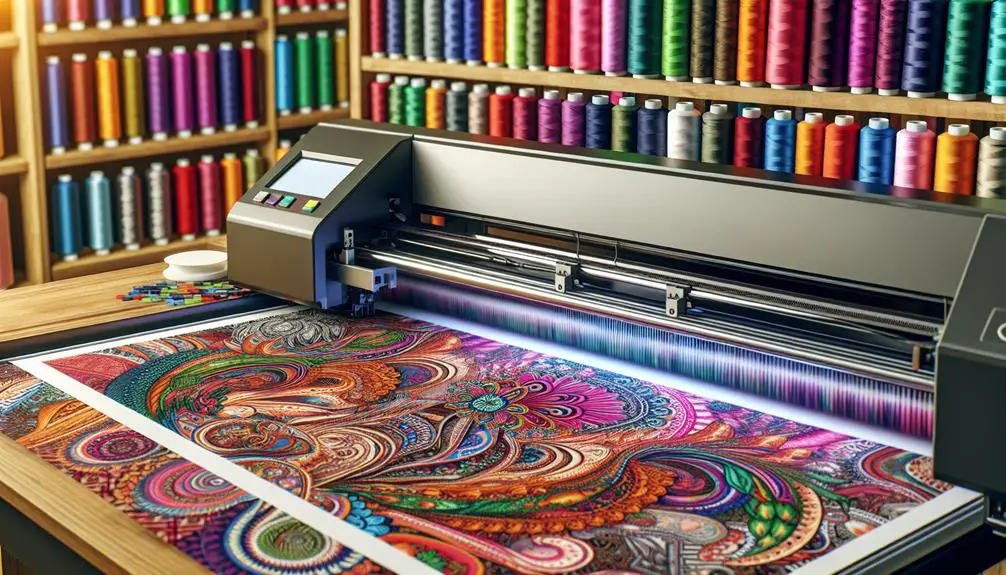You're about to enter the fascinating world of digital printing on fabrics, where your creative ideas can materialize with remarkable precision and vivid detail. This guide aims to walk you through the basics, from understanding what digital fabric printing is to selecting the best materials and equipment. Imagine having the ability to produce intricate patterns and vibrant colors on various textiles, all from the comfort of your own studio. But before you start creating your masterpieces, there are a few essential concepts and tools you'll need to grasp. Curious about where to begin? Let's get started.
Table of Contents
Key Takeaways
- Definition and Process: Digital fabric printing involves directly applying ink onto fabric using digital printers, offering precision and detailed designs.
- Types of Inks: Choose appropriate inks like pigment, reactive, acid, or disperse based on fabric type for best colorfastness and durability.
- Fabric Selection: Select compatible fabrics such as cotton, polyester, silk, or nylon to ensure optimal print quality and color vibrancy.
- Design Preparation: Properly prepare designs with accurate color management and pre-treatment of fabrics for high-quality prints.
- Printing and Curing: Follow correct fabric loading, alignment techniques, and curing processes to achieve long-lasting and vibrant prints.
What Is Digital Fabric Printing?
Have you ever wondered how intricate designs get printed onto fabrics with such precision? The answer lies in digital fabric printing, an innovative printing technique that revolutionizes textile production.
Unlike traditional methods, digital printing involves directly transferring designs from a computer onto fabric, providing unmatched accuracy and detail.
You'll find that this process opens up endless design possibilities. With digital printing, you can customize fabrics with complex patterns, vivid colors, and intricate motifs that might be impossible to achieve with conventional methods.
The technology uses specialized inks and advanced printers, enabling you to produce high-quality prints on various fabric types, from cotton to silk.
Fabric customization has never been easier or more efficient. You don't need to worry about high minimum order quantities or extensive setup times. Digital printing allows for quick turnaround, making it ideal for both small-scale projects and large production runs.
Plus, you can easily alter designs or colors without much hassle, offering unparalleled flexibility.
Benefits of Digital Printing
Digital printing offers numerous advantages that make it a game-changer in the textile industry. You'll find that it provides unparalleled design flexibility, allowing you to bring even the most intricate patterns to life with ease. Unlike traditional methods, digital printing lets you experiment with a broader spectrum of colors and designs without the need for costly setups.
In terms of cost efficiency, digital printing can save you a significant amount of money, particularly in small batches. There's no need for expensive screens or plates, so you can produce high-quality prints without the hefty initial investment.
Moreover, digital printing is known for its quick turnaround times. You can go from concept to finished product in a fraction of the time it would take using traditional methods. This speed is essential for staying competitive in today's fast-paced market.
Digital printing also scores high in environmental sustainability. It uses less water, fewer chemicals, and generates less waste, making it a more eco-friendly option.
Here are the key benefits:
- Design flexibility: Unlimited creative potential.
- Cost efficiency: Reduced initial setup costs.
- Quick turnaround: Faster production times.
- Environmental sustainability: Lower environmental impact.
- High-quality output: Sharp and vibrant prints.
Essential Equipment
To get started with digital fabric printing, you'll need to understand the different types of printers available and the software tools required.
Each printer type has its own strengths and applications.
Additionally, the right software will help you design and manage your prints efficiently.
Printer Types Overview
When diving into digital printing on fabrics, you'll find that understanding the different types of printers available is essential. Your choice of printer can greatly impact the quality, efficiency, and versatility of your printing projects.
Let's break down the main types:
- Inkjet printers: These are versatile and widely used. They work well for small-scale projects and can print directly onto fabric.
- Dye sublimation printers: Perfect for polyester fabrics, they use heat to transfer dye onto the material, creating vibrant, long-lasting prints.
- Direct to fabric printers: These machines print directly onto various fabrics without the need for transfer paper, ideal for high-quality and detailed designs.
- Heat transfer printing: This method involves printing your design on special transfer paper and then using heat to transfer it onto the fabric. It's great for intricate or multi-colored designs.
- Hybrid printers: These combine multiple printing methods, offering flexibility and a broader range of fabric compatibility.
Mastering these printer types will allow you to choose the best equipment for your specific needs, ensuring your fabric prints are of the highest quality. Focus on learning the strengths and limitations of each to optimize your process.
Necessary Software Tools
Understanding the various types of printers is just one part of the equation; you also need reliable software tools to bring your fabric printing projects to life.
Start with top-tier design software like Adobe Illustrator or CorelDRAW. These programs allow you to create intricate patterns and detailed designs with precision. You'll find that mastering vector graphics is essential for scaling your designs without losing quality.
Next, focus on color management. Accurate color representation is vital in fabric printing. Tools like Adobe Photoshop and dedicated color management software such as ColorMunki or X-Rite i1Profiler guarantee that the colors on your screen match those on the final fabric. Invest time in learning how to calibrate your monitor and create custom color profiles for your printer and fabric type.
Additionally, consider software that offers seamless integration between your design and printing process. RIP (Raster Image Processor) software like Wasatch or Onyx can optimize print quality and manage your workflow efficiently. These tools convert your design files into the specific format required by your printer, ensuring that every detail is captured accurately.
Types of Inks
In digital fabric printing, the choice of ink—whether pigment, reactive, acid, or disperse—directly affects the quality and durability of the final product. Each type of ink has distinct properties, application techniques, and curing requirements that influence color vibrancy and longevity.
- Pigment Inks: Known for their versatility, pigment inks sit on the fabric's surface and require heat-setting for ink curing. They offer good color fastness but can feel slightly stiff.
- Reactive Inks: Ideal for natural fibers like cotton and silk, reactive inks chemically bond with the fabric, resulting in vivid colors and excellent color fastness. They need steaming for proper ink curing.
- Acid Inks: Best suited for protein-based fibers such as silk and nylon, acid inks provide brilliant colors and exceptional wash fastness. Similar to reactive inks, they require steaming.
- Disperse Inks: These inks are used for polyester and synthetic blends. They penetrate the fibers through sublimation, producing vibrant, long-lasting prints. Heat is essential for curing disperse inks.
Mastering these inks means understanding their specific properties and application techniques. Ensuring proper ink curing will enhance color fastness, thereby increasing the print's durability and vibrancy. Choose wisely to produce the best possible results in your digital fabric printing projects.
Choosing the Right Fabric
When you're choosing fabric for digital printing, it's important to understand the different types available and their compatibility with various inks.
You'll need to take into account factors like fabric texture, fiber content, and how well the material holds color.
These tips will help you select the best fabric for your specific printing needs.
Fabric Types Overview
Choosing the correct fabric is essential to ensure your digital printing project turns out flawlessly. The type of fabric you select plays a pivotal role in determining the quality and longevity of your print. Each fabric offers unique characteristics that can impact the vibrancy, durability, and feel of the final product.
Let's delve into some of the most popular fabric types and what they bring to the table.
- Polyester blends: Ideal for vibrant, long-lasting prints. These blends are durable and resistant to fading.
- Cotton weaves: Known for their soft texture and breathability, making them perfect for apparel and home textiles.
- Silk textures: Offer a luxurious feel and rich color depth, though they require careful handling.
- Linen patterns: Provide a natural, textured finish that's excellent for rustic or high-end designs.
- Synthetic fabrics: Versatile and cost-effective, often used for a variety of applications from fashion to banners.
Material Compatibility Tips
Understanding material compatibility ensures your digital printing projects meet your expectations in both appearance and performance. Choosing the right fabric is essential. Different fabrics react uniquely to various ink types, and each printing technique demands specific fabric properties for best results.
Proper fabric preparation is the foundation. Pre-treat your fabric to optimize it accepts the ink well, reducing risks like bleeding or fading. Also, consider color management. Different fabrics display colors differently, so adjust your designs accordingly for the best visual outcomes.
Here's a quick guide to help you match fabrics with appropriate ink types and printing techniques:
| Fabric Type | Recommended Ink Types & Techniques |
|---|---|
| Cotton | Reactive, Pigment inks; Direct-to-Garment (DTG) |
| Polyester | Sublimation, Disperse inks; Dye-Sublimation |
| Silk | Acid, Reactive inks; Digital Textile Printing |
| Nylon | Acid, Disperse inks; Transfer Printing |
| Blends (Cotton/Poly) | Pigment, Sublimation inks; Hybrid Printing Techniques |
Step-by-Step Printing Process
To start the digital printing process on fabrics, you'll need to prepare your design and choose the right type of fabric. Begin by making sure your design is in high resolution; this will guarantee sharp, vibrant prints. Consider the printing techniques and color mixing you'll use, as these will impact the final output.
Next, follow these steps:
- Pre-treat the fabric: Pre-treating enhances color absorption and ensures durability.
- Set up your design: Make sure the design placement is accurate on your fabric layout. Proper image resolution is essential for a crisp print.
- Load the fabric: Secure the fabric onto your printer, ensuring it's aligned correctly to avoid any misprints.
- Print the design: Using your chosen digital printing techniques, start the printing process. Pay attention to color mixing to achieve the desired shades and gradients.
- Cure the print: Once printed, you'll need to cure the fabric, typically through heat setting, to fix the colors and make them long-lasting.
Design Tips and Tricks
Anyone looking to create stunning fabric prints should focus on a few key design tips and tricks to elevate their work. First, master color blending. This involves smoothly shifting between shades and hues to create depth and dimension in your designs. Use gradient tools in your design software and experiment with different color combinations to find what works best for your fabric. Remember, subtlety can make a significant impact.
Next, pay close attention to pattern placement. Whether you're working with repeating motifs or a single, bold design, placement is essential. Align your patterns precisely to guarantee a seamless look, especially when working with larger pieces of fabric. Use templates and guides to help you visualize the final output and make necessary adjustments early in the design process.
Additionally, consider the fabric's texture and weave. Some designs may look fantastic on screen but mightn't transfer well onto certain fabrics. Test your designs on small fabric swatches before committing to larger prints. This step will help you understand how colors and patterns interact with the fabric's surface.
Common Challenges
Tackling common challenges in digital fabric printing will help you achieve professional and high-quality results. One major hurdle is guaranteeing color precision. Variations in fabric types and ink formulations can lead to discrepancies between your digital design and the final print. To mitigate this, always conduct test prints and calibrate your printer regularly.
Another common issue is achieving high print resolution. Low resolution can make your designs look pixelated and unprofessional. Use high-quality images and regularly maintain your printer heads to avoid this problem.
Fabric preparation is essential for successful printing. Without proper pre-treatment, ink may not adhere well, leading to faded prints. Make sure your fabric is clean and properly pre-treated according to the manufacturer's guidelines.
Ink adhesion is another challenge. Different fabrics require different inks for best adhesion. Always match your ink type to the fabric type to ensure the most favorable results.
Here are some key tips to master these challenges:
- Conduct test prints for color precision
- Use high-resolution images
- Regularly maintain printer heads
- Properly pre-treat fabric
- Match ink type to fabric type
Care for Printed Fabrics
Preserving the longevity of your digitally printed fabrics requires proper care and maintenance. Start with washing instructions: always use cool water and a mild detergent. Turn the fabric inside out to safeguard the print, and refrain from using bleach or fabric softeners as they can deteriorate the design. Hand washing is ideal, but if necessary, choose a delicate cycle on the machine.
When it comes to drying, air drying is preferable. If you opt for a dryer, select a low heat setting to avoid any heat-related damage. Ironing should be done on the opposite side with a low-temperature setting to maintain the print's integrity.
Storage tips are also essential. Keep your printed fabrics in a cool, dry area away from direct sunlight to prevent fading. Fold them neatly, avoiding sharp creases that may alter the print over time.
Consider the environmental impact of your washing habits. By using cool water and air drying, you're not only preserving the fabric but also reducing energy consumption.
Addressing longevity concerns effectively guarantees your printed fabrics stay vibrant and intact for years, allowing you to appreciate their beauty while practicing sustainable care.
Frequently Asked Questions
How Can I Start a Business in Digital Fabric Printing?
To start a digital fabric printing business, you'll need solid business planning and a robust marketing strategy. Source reliable suppliers, invest in high-quality equipment, and guarantee regular maintenance. Don't forget to keep your eyes peeled for any flux capacitors!
What Are the Costs Associated With Digital Fabric Printing?
To understand the costs associated with digital fabric printing, you'll need a thorough cost analysis and budgeting plan. Focus on effective pricing strategies to guarantee healthy profit margins while considering equipment, materials, labor, and overhead expenses.
Are There Any Eco-Friendly Options for Digital Fabric Printing?
Yes, you can definitely find eco-friendly options for digital fabric printing. Use eco-friendly materials like organic cotton and water-based inks. Adopt sustainable practices, such as reducing water waste and energy consumption, to minimize environmental impact.
How Do I Convert Traditional Designs for Digital Printing?
To convert traditional designs for digital printing, you'll start with design adaptation, ensuring your artwork is digitized. Focus on color matching to maintain the original's vibrancy. Fine-tune details for high-resolution output and best results.
Can Digital Fabric Printing Be Used for Mass Production?
Yes, you can use digital fabric printing for mass production, but you might face scalability limitations and production challenges. However, it offers incredible customization opportunities and can meet market demand for unique designs efficiently.
- How Does Ring Spun Cotton Affect Garment Fit and Shape Retention? - August 13, 2024
- What Are the Challenges in Producing Ring Spun Cotton? - August 13, 2024
- Is Ring Spun Cotton Suitable for Plus-Size Clothing? - August 13, 2024







